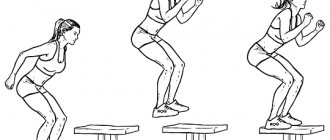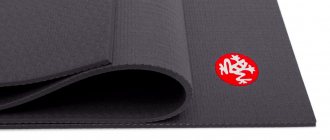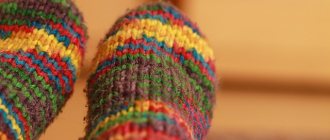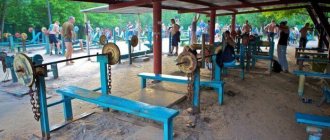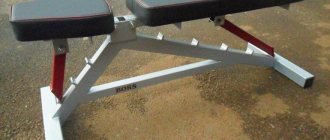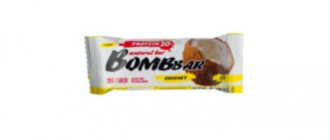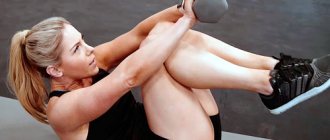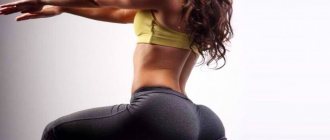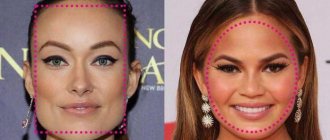To perform exercises at home, in the gym, or in the club, you will definitely need a fitness mat. Even if you go to an expensive fitness club that provides clients with the necessary equipment, for purely hygienic reasons it is better to have your own mat. In addition, you will be able to use not what you got, but what suits you personally in color, texture, and size. How to choose a fitness mat that will delight you during your workouts? More on this later, but first I would like to spend a few words on why it is needed.
Functionality
The fitness mat ensures the safety and comfort of training by performing the following functions:
- absorbs sweat;
- provides comfort for classes (the floor is hard and uncomfortable);
- protects the spine, knees, palms, feet, head from injuries and pain;
- prevents colds during the cold season due to drafts moving across the floor;
- lifts the mood;
- an expensive and stylish thing can serve as a good motivation for regular exercise.
In the halls you may be offered mats for common use so that you do not have to bring your own from home each time. But think about the fact that they are rarely washed (if washed at all) and how many bacteria from other people’s bodies accumulate there. In addition, when performing exercises from a lying position, there is always a risk of ending up with your head where someone’s legs were recently. There is only one way to get around these unpleasant moments - buy your own rug.
Mat material
Today, manufacturers use several materials in the production of such equipment:
- Mat made of synthetic material, PVC. A synthetic mat is relatively inexpensive, so it is perfect for those who are not in the mood for serious and regular sports. It won’t be a shame to say goodbye to him after just a few classes. For the manufacture of this product, high-strength and elastic PVC polymer is used. The service life of a synthetic rug is two years. Fragility and the release of unpleasant odors are the main disadvantages of this model.
- Fitness mat made of thermoplastic elastomer. The main advantages of this product include lightness, elasticity and softness. In addition, this model is durable, moisture-resistant, and pleasant to the touch. The thermoplastic elastomer mat does not fade and does not slip. The service life of such equipment is five years. Considering the above advantages, this model is more expensive than the previous one.
- Rugs made from natural material are mainly purchased by people who have been involved in intense sports for many years. Their cost is quite high. These products are high quality, waterproof and do not emit unpleasant odors.
Natural mats prevent slipping and are thermally insulating. One of the most common models is a mat made of rubber with the addition of rubber or a rope that is not electrified. The natural mat is highly dense, which makes it comfortable when placing your knees or elbows on it. The disadvantages include heavy weight and inconvenience in moving and transporting.
In addition to rubber products, manufacturers offer sports mats made of latex, polyurethane foam, polyurethane, natural cotton or wool. They are very light in weight, absorb well during exercise, and reliably protect from the cold of the floor. Such mats can even be laid on the ground when exercising outdoors.
In the sports equipment market, you can choose a variety of quality products. Popular types of materials from which a gymnastic fitness mat is made:
- PVC - does not fade, is easy to clean from dirt, but is not suitable for yoga.
- Thermoplastic is soft to the touch, suitable for various types of training, but is more expensive than PVC.
- Rubber is a natural material that does not absorb moisture, but it is heavier than other types of rugs.
- Cotton - the products are pleasant to the touch, but they are uncomfortable to exercise on because they slip on the floor.
One of the most affordable types of mats, based on foam rubber. Good for beginners, but poor quality material. Price for 1 piece. around $5. They are comfortable, compact, soft for training and hypoallergenic. If you have no finances, this is the most suitable option.
However, they are short-lived and, with intensive use, will lose their quality after 6-12 months. Synthetic bases may cause an unpleasant odor.
Advantages:
- cheap price segment;
- the presence of a porous structure makes them soft;
- compact and easy to transport.
Flaws:
- the presence of a slippery surface;
- rapid wear during intensive use;
- weak elasticity, which leads to rapid wear of the surface;
- Synthetics can cause an unpleasant odor when rubbed.
The cost is higher than EVA, but the quality of the material is better. Rugs made from this material are thicker, comfortable and of course soft. Their slipperiness is lower than that of the ones described above, but not much, and they are more convenient for fitness training than for yoga training. Their cost already fluctuates around $15.
The wear resistance of the mat is already an order of magnitude higher, the service life increases, density and softness are also present. The thickness of the material is 10-15 mm.
Advantages:
- dense, elastic structure that slowly stretches throughout classes;
- wear resistance and strength are at an average level;
- The thick base is soft in feel and comfortable for fitness training;
Flaws:
- quite slippery surface;
- The price segment of the rug is quite high.
The material is pleasant to the touch, lightweight and has a wear-resistant surface. The cost category is around $22.
A mat made from the proposed material is the most suitable option for yoga, since there is no slippery surface, it has a dense base, thanks to which its original shape is preserved, and the weight is insignificant. Oddly enough, this is also a great option for fitness; they do not deteriorate in the sun, so you can train with them outdoors.
The unpleasant thing is that when your legs and arms sweat, the moisture is not absorbed and remains on the mat, which is not always convenient for further exercise.
Advantages:
- pleasant soft surface;
- dense material retaining its original appearance;
- increased anti-slip characteristics;
- resistant to fading under sun exposure;
- prevents the spread of fungi and bacteria;
- a suitable option for yoga classes.
Flaws:
- high price;
- the surface does not absorb moisture enough and remains damp;
- upon contact with synthetics, the material can become electrified;
It perfectly absorbs moisture even with heavy sweating (therefore it is good for yoga), it is wear-resistant, and the material itself is environmentally friendly. Price about $36. Upon contact, the material is pleasant and creates grip on the body at an almost ideal level. It belongs to the heavy weight category and is not as durable as other options, but it is environmentally friendly. It is not for nothing that this material is most valued; it does not contain chemical compounds and does not emit toxins.
Advantages:
- excellent material for yoga classes;
- adheres the material well to the surface of the body;
- environmental characteristics;
- no electrification effect;
- absence of unpleasant or pungent odors;
- no heavy metals or toxic substances.
Flaws:
- the price is too high;
- more suitable for yoga than for fitness;
- durability is not high;
- heavy to transport.
Kinds
Before you go looking for a fitness mat, you should understand the range on offer and evaluate the pros and cons of each type.
By material
Synthetic (PVC)
PVC - polyvinyl chloride, a synthetic polymer. It is durable and lightweight. One of the cheapest materials: such mats cost around $17. They last no more than 2 years and are used mainly at home. They are not suitable for professional fitness, as they have one significant drawback - they slide across the floor during intense movements. May also produce an unpleasant odor over time.
Thermoplastic elastomer (TPE)
Mid-priced: These mats will cost about $20. Thermal Plastic Elastomer is a synthetic but hypoallergenic material. It is elastic and soft, has an anti-slip effect, and absorbs sweat well. The surface does not fade. Service life - more than 3 years.
Rubber with the addition of rubber / jute
A high-quality rubber mat is quite expensive - from $35. They are heavier than the others, but they are recommended to be chosen for fitness classes in the gym. They do not slip, do not electrify, are quite thick, moisture-proof, do not emit any odors, and have thermal insulation properties. The disadvantage is its impressive dimensions, which will not be easy to handle in public transport.
From natural materials, in addition to rubber, latex, polyurethane foam, wool, and cotton are also used. All of them are very light, have excellent shock absorption and thermal insulation. You can take them with you to outdoor activities. True, they are quite expensive and not so easy to find.
Thickness and softness
Ab mats (simple)
Small, but dense, hard, rather thick rug. Ideal for pumping up the abs, but when performing other exercises it can cause inconvenience (slips). The approximate cost is around $17.
Workout mats (sports)
Much larger in size than Ab mats, softer. They consist of several segments, have an anti-slip effect, and provide good shock absorption. Ideal for home fitness. Price category: average: up to $20.
Mind body (for body)
Such mats can be called professional; they are perfect for training in the gym. They can be used for both fitness and yoga. Excellent shock absorption. They belong to the premium class (can be very expensive, $50-70). For example, the Manduka SuperLite Travel Mat is listed for $69.
Other types
"Smart"
The age of computer technology and mobile applications has reached fitness. It is worth paying attention to a new product that was developed quite recently. This is a smart mat that looks completely normal in appearance. But underneath the top layer of polyurethane foam is a mesh of conductive material with embedded software. This mat is called “smart” because it knows when its owner is standing and when he is lying down, what his ideal and actual weight is, what load is placed on different parts of the body in certain positions. All this data is sent to the Android application and allows you to more accurately adjust your workouts to improve their effectiveness. This new product costs $300.
Folding
The size of fitness mats should be such that the body fits comfortably on them and there is no risk of rolling onto the floor with any wrong movement. That is, they must be large enough. For ease of transportation from home to the gym and back, manufacturers offer mobile folding models. They are divided into segments, along the lines of which they fold and turn into a small and compact package, convenient for transportation. A very interesting option is the Original Fit Tools PVC folding mat for only $13.
Mat-bag
A variation of the previous option. After classes, you can fold it into segments (usually 3-4) and get a convenient bag with handles. It’s not a problem to travel with this one even on public transport. But this is perhaps the only plus. Otherwise, it is inferior to other models: it does not absorb moisture, slips heavily on the floor, and is made of synthetic materials. Cost - up to $17.
When choosing a mat, think about suitable fitness sneakers. About this in our article.
How to choose a fitness mat?
Now we should make a new distinction and separate yoga mats from fitness mats.
In this material, the first half is devoted specifically to yoga mats, and the second to fitness surfaces, and this division is very reasonable, since these fabrics have different functional properties. A typical example is Reebok rugs, which are offered in exactly two types in the indicated areas. As you know, everyone who overcomes their own laziness will achieve progress in yoga, but sometimes, when the surface of the mat is not at all pleasing, you don’t want to perform asanas, and it’s simply inconvenient and difficult to force yourself to practice. In many ways, such inconveniences can be caused by the thickness of the rug. There are three main options to note:
- 3-4 mm. – the thinnest, camping ones;
- 4-6 mm. – medium, for the hall;
- from 8 millimeters - for streets and uneven surfaces.
If we take the thinnest options, then it is quite possible to consider something like the Nike Essential Yoga Mat, Manduka eKO Mat or the famous Kailas model from Bodhi, they are not only thin, but also light and are an excellent option for a hiking mat. However, if you use such a carpet on a hard surface, and even more so on uneven surfaces, then you are almost guaranteed to experience inconvenience when rolling, unpleasant sensations in your elbows and knees, and similar “joys” of working out on hard surfaces.
Of course, for a true yogi, every challenge is a joy, but if you want to achieve progress through more peaceful methods and maintain ahimsa in relation to your own body, then choose a medium thickness.
It’s difficult to say which yoga mat is better, choose based on your own sensitivity. If you can perform asanas on a fairly hard surface, then you can choose something like the thin Rishikesh (Bodhi brand), if you want to be able to relax and not experience pain when resting your joints and chin, then take the thicker option.
Sometimes it’s even important to choose an option like Airex - a thick, centimeter-long mat, although a little short, nevertheless, on such a carpet you can perform exercises for a long time and not experience discomfort.
Stickiness
Perhaps many of the readers know about the ideal performance of artha-mukha-svanasana, the so-called “downward dog” or “slide”. According to ancient treatises, perfectly executed artha-mukha-svanasana ensures stability even on the surface of ice.
However, ideals are ideals, and now, most likely, doing a slide in the middle of class and bursting with sweat, you begin to slip your palms and feet along the surface and the pose turns out to be unstable and does not bring any joy at all. Actually, many other asanas require that the surface be a little sticky and allow it not to slip. Therefore, the factor of stickiness and lack of slippage is more than significant.
The best yoga mats offered by manufacturers are highly sticky and in some ways make your practice easier and increase your stability. Typical examples here are products from Manduka (only these mats cannot be washed or say goodbye to stickiness) or Reebok, which just need to be lightly washed or wiped before use, since Reebok uses a special transport compound for mats.
If you have the opportunity to touch the product, then checking the stickiness is not difficult. Simply rest against the carpet on a flat surface and press mostly along the surface. Ideally, your palm will not slip at all, although we still advise you to strive not for the ideal mat, but for the ideal artha-mukha-svanasana on ice in the best traditions of the Himalayan ascetics.
Size
It is more than important in terms of practicing yoga and we are not talking about the length of your hold on exhalation or staying in paschimotanasana, we are talking about the size of the yoga mat, which must be chosen individually. As it is not difficult to understand, the main parameter of choice here is the length of your body.
For owners of a relatively short body, as they say about a meter with a cap, the previously noted 140 centimeter Airex may well be enough. Of course, to relax, you will have to use some kind of support under your head or feet, but in general, even this length is enough for asanas. If you are 180-200 centimeters long, then a short rug is a waste for you.
Not many manufacturers offer rugs of impressive length, because some want to make lighter, others more compact models. However, it is better not to skimp on the length and choose something of the order of 200-220 centimeters. This size will allow you to comfortably perform the entire range of asanas, including:
- dynamic rolls;
- inverted;
- twines;
- whole body traction;
- stands in a low position.
In addition, you will be able to lie comfortably on a mat of this size.
Materials
In order to choose the best option, check the offered quality certificates. Normal products always come with these and have an optimal composition. Unlike the fitness mats described below, yoga surfaces are often made from natural materials.
For example, the previously mentioned products from Manduka are just that. Only natural rubber that allows you to touch the mat with all your pores and chakras, even svadhisthana, without any fear.
The sports industry offers a choice of three main varieties, based on different goals:
- ab mats – used for pumping the core and the whole body, have high thickness and hardness;
- workout mats – used mostly for gymnastics, the difference lies in the presence of several segments along which the mats are folded;
- mind body - closest to the yogic version, they have high-quality cushioning and a pleasant texture.
Thus, which mat is best for fitness depends on the purpose and specifics of your exercise. Of course, the first two types of rugs are quite specific varieties, so next we will consider the most familiar soft rugs without segments as the main option.
Material selection
Which material to choose? Natural products or synthetics? Often the best option is something in between, like a combination of cotton fabric and PVC.
If you choose a natural rug, it is best to take natural rubber and rubber, to which cotton or jute fibers are added. They are quite heavy, but this has an advantage - stability.
Synthetics are usually made from PVC. The material is not natural, but there are quite worthy examples, much depends on the manufacturer and additional components. Another thing worth noting is thermoplastic elastomer (TPE), which not only holds its shape better and is softer, but also absorbs moisture less.
Many people experience increased sweating when exercising. Therefore, a very relevant addition to the material of your rug is a special antibacterial impregnation. In addition, it is useful to purchase a product reinforced with lavsan threads; such mats do not stretch, slip less and are generally stronger.
Size
As a rule, the proposed sizes of a fitness mat vary in the range from one and a half to two or more meters. The most optimal calculation option is to increase the length of your body by 10-15 centimeters.
The size in diameter is for the most part identical - about 60 centimeters. However, it is often better to choose a larger size. Even the difference between 58 and 61 centimeters is felt quite significant.
We repeat, if you only want to have a small warm-up mat, then the compact size of ab mats is quite enough.
For home use, we can recommend several mats that are suitable for training on different parts of the body, using dumbbells and weights. They should not slip, they should be easy to clean, and you should also pay attention to whether the rugs are prone to collecting harmful microorganisms (this can happen more often with rugs made from natural materials).
There are many offers on the market, some of them can be cited.
- Gymnastic mat Bradex (price is approximately 850-900 rubles). Non-slip mat 0.3-0.5 cm thick with rounded edges. Due to its thickness, it is suitable for abdominal exercises and does not slip.
- Mat from Verdani model “Sport” (combines good quality at a reasonable price of 300 rubles). The corrugated rug is made of polyethylene foam and has a short length of up to 180 cm. It is well suited for the home, as it does not allow heat or cold, as well as moisture, to pass through. You can do any muscle development exercises.
- Spokey rug (price around 1000 rubles). Very durable, does not slip at all. It folds easily, has handles for carrying, and lasts a long time. Easy to store as it has straps for folding.
- Feco rug. A thin mat costs up to 800 rubles and has a storage case. Designed for abdominal exercises and leg swings.
- Alonsa products have a price range from 200 to 600 rubles. The shape allows you to perform exercises while lying down and is not prone to slipping. Has handles for carrying.
There are a number of requirements to consider in order to make the right choice when purchasing sports equipment. To understand which fitness mat is best, you should pay attention to the following nuances:
- For length - ideally, the product should exceed height by 10 cm for beginners and 20 cm for professionals.
- By weight – sports equipment whose weight ranges from 1 to 2 kg is considered comfortable.
- For moisture permeability – it is not comfortable to practice on surfaces that do not absorb moisture well.
- Elasticity – it is important that the mat does not stretch, otherwise its service life will be short.
It is imperative to pay attention to the thickness of the product before purchasing. Too thin options can cause injury to the joints and spine. Which fitness mat will be better should be chosen individually. Older people are advised to purchase thick products, this will prevent pain during training.
Thickness of mats and their purpose:
- 1.5-3 mm – suitable for classical yoga and aerobics training;
- 3-4 mm – optimal thickness of universal sports equipment;
- 5-6 mm – suitable for people with sensitive joints;
- Over 6 mm - used during exercise on uneven surfaces.
Criterias of choice
To choose the right fitness mat, take into account several criteria that allow you to evaluate the product from different angles and purchase the best option.
- Size
A beginner adds 5 cm to his height and gets the optimal length, a more experienced one adds 10 cm. You shouldn’t take one that is too wide (80 cm) - it takes up a lot of unnecessary space and is inconvenient for transportation. 60 cm is the ideal width. The thicker, the safer (6-8 mm is the recommended parameter).
- Weight
It all depends on your physical fitness. There are light products (250-300 g), and there are massive ones (5-6 kg). The first ones are convenient for transportation, but they slide on the floor. So for the gym, look for the golden mean (1-2 kg).
- Grip on floor and body
Move your favorite model across the floor. A sliding mat is dangerous, it will constantly fidget under you and move in waves. The rubberized base, on the contrary, is a guarantee of safety.
- Moisture permeability
During fitness you have to sweat, and it is very unpleasant if by the end of the session the mat gets very wet. Therefore, choose porous structures (latex, cotton) that absorb moisture well.
- Elasticity
If the mat stretches in different directions like rubber, it will not last long. Choose a durable frame, for the creation of which manufacturers include lavsan fibers in their products.
- Color
Fitness should give you a good mood, so you shouldn’t choose black and dark shades. Manufacturers offer the brightest colors - from lemon yellow to deep blue.
- Mobility
For the home, regular tape is suitable - heavy, dimensional, thick. For the hall, it makes sense to choose a lighter, thinner model that quickly folds into segments and comes complete with a case (bag).
- Purpose
For abdominal exercises, ab mats will be enough. For more complex fitness, it is better to choose folding segmented workout mats. For Pilates or stretching - elastic mind body.
- Material
If you are working out temporarily for weight loss, inexpensive PVC options are suitable. If you love comfort, if you are a professional Pilates or stretching enthusiast, buy TPE. Those for whom fitness has become a hobby can splurge on natural textures.
A wide range of fitness mats are sold on online resources. But this is a thing that, when purchased, you need to touch, spread, and check for adhesion to the floor. Therefore, go shopping to a good sports store. The product is certified there, and consultants will clarify the characteristics and answer questions about a particular model.
Gymnastic mat sizes
This parameter depends on the type of training and physical characteristics of the practitioner. What should a training mat be like:
- The length of the product varies from 120 to 220 cm. If training takes place at a calm pace, then add another 10 cm to your height indicator, if at a dynamic pace, then 30 cm.
- The width of the equipment ranges from 50 to 80 cm. A wide fitness mat is inconvenient when moving in public transport.
- Thickness 1.3-8 mm. The optimal indicator for comfortable training is 3-4 mm. It will not be cold and soft.
The length of the mat is chosen to be greater than height, at least 10 cm. If the mat is intended for yoga, then its thickness should be at least 4-6 mm. This thickness is the most convenient for performing a variety of asanas; some yoga experts use even thinner ones within 2-3 mm.
If you plan to use the mat for fitness training, then its thickness should range from 6-10 mm, which will be a convenient indicator for performing jumping exercises. You should not take more thickness, as it will reduce the stability and balance of the torso.
Rating
It's difficult to choose the best rug. For some, the main criterion is price, for others - the country of origin, for others, quality characteristics come first. A small rating will help you get your bearings.
- Adidas (Germany). Synthetics. $88.
- Spirit Fitness (USA). PVC. $79.
- Reebok (USA). Ecopena. $67.
- Torneo (Russia). Synthetics. $47.
- Yogamat (China). PVC. $18.
- Bradex (Israel). Foamed ethylene vinyl acetate. $15.
- Fitness Tools (China). PVC. $15.
- LiveUp (China). PVC. $14.
- EVA Hawk (China). Foamed polyethylene. $7.
- Demix (Russia). Polyethylene. $4.4.
There's no need to explain why Adidas and Reebok are so expensive: these sports equipment pillars know a lot about making such products. However, you will also have to pay extra for a famous name. Therefore, it is worth thinking about more mundane numbers. For example, there is no need to be prejudiced towards Chinese goods. Many fitness instructors suggest buying Yogamat and Fitness Tools brands, which have a good price-quality ratio.
Rules of care
In order for the rug to last as long as possible, it needs to be properly cared for. A few general recommendations will allow you to enjoy it for more than one year:
- Carefully study the manufacturer's recommendations.
- You can only exercise in socks or barefoot.
- Fold it only if there are segments, otherwise roll it up.
- The roll should not be too dense; roll it from a different side each time.
- Synthetic materials are rinsed by hand once every 1-2 months (depending on the intensity of exercise) in a warm soapy solution and dried in a vertical position.
- Natural products are wiped with a damp cloth.
- To avoid odor, after each workout the mat should be hung out in the fresh air for a couple of hours.
- As soon as peeling and creases appear, purchase a new one.
- This is the same personal hygiene item as a towel or comb, so do not let other people use it.
The service life is 50% dependent on proper care. The remaining 50% depends on the intensity of training and the quality of the product.
With your own hands
Theoretically, you can make a fitness mat with your own hands. Theoretically, because this process is complicated by acquiring the necessary material, which is not so easy to find. But if you find it, everything else is easy to do.
- Purchase the necessary material: PVC, TPE, rubber. The length of the piece is 2 m, the width is no more than 1 m.
- Add + 10 cm to your height and + another 2 cm on top and bottom (for stitching). Either leave the width or shorten it to the standard 60 or 80 cm, but do not forget to leave 2 cm for the stitching on the left and right.
- Make markings with chalk.
- Cut with scissors.
- Sew the edges with a sewing machine, otherwise they will quickly fray and the mat will fail.
The only advantage of such a hand made product is that it turns out inexpensively. Disadvantages: without special inserts in the form of lavsan fibers, the product will be fragile; without a rubberized base, it will be slippery.
If you want to enjoy fitness and minimize the risk of injury, be sure to purchase a mat. On those days when you are too lazy to get up from a cozy sofa and go to class, look at it and let it serve as a motivator not to give up training. After all, the end result will be a beautiful figure and excellent health.
Have you sorted out the rug? Then we suggest choosing and studying fitness exercises.
Cotton
Cotton is a hypoallergenic material that does an excellent job of absorbing moisture. A cotton sports mat has one feature - the more it gets wet, the more reliable the grip. A cotton rug is used as an overlay for a plain carpet. As a result, the surface becomes much softer, and thermal insulation provides comfortable conditions for exercise.
Our company produces rugs from various materials. If you want to buy fitness mats inexpensively, we are pleased to offer you a wide range of yoga mats made from natural and synthetic raw materials in various colors.
